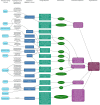Making it transparent: A worked example of articulating programme theory for a digital health application using Intervention Mapping
- PMID: 38894945
- PMCID: PMC11185015
- DOI: 10.1177/20552076241260974
Making it transparent: A worked example of articulating programme theory for a digital health application using Intervention Mapping
Abstract
Objective: Digital health interventions for behaviour change are usually complex interventions, and intervention developers should 'articulate programme theory', that is, they should offer detailed descriptions of individual intervention components and their proposed mechanisms of action. However, such detailed descriptions often remain lacking. The objective of this work was to provide a conceptual case study with an applied example of 'articulating programme theory' for a newly developed digital health intervention.
Methods: Intervention Mapping methodology was applied to arrive at a detailed description of programme theory for a newly developed digital health intervention that aims to support cardiac rehabilitation patients in establishing heart-healthy physical activity habits. Based on a Predisposing, Reinforcing, and Enabling Constructs in Educational Diagnosis and Evaluation (PRECEDE) logic model of the problem, a logic model of change was developed. The proposed mechanisms of action were visualised in an acyclic behaviour change diagram.
Results: Programme theory for this digital health intervention includes 4 sub-behaviours of the main target behaviour (i.e. habitual heart-healthy physical activity), 8 personal determinants and 12 change objectives (i.e. changes needed at the determinant level to achieve the sub-behaviours). These are linked to 12 distinct features of the digital health intervention and 12 underlying behaviour change methods.
Conclusions: This case study offers a worked example of articulating programme theory for a digital health intervention using Intervention Mapping. Intervention developers and researchers may draw on this example to replicate the method, or to reflect on most suitable approaches for their own behaviour change interventions.
Keywords: Behavior and behavior mechanisms; Cardiac rehabilitation; Cardiovascular diseases; Digital health; Health promotion; Public health; Secondary prevention; Telemedicine.
© The Author(s) 2024.
Conflict of interest statement
The authors declared no potential conflicts of interest with respect to the research, authorship, and/or publication of this article.
Figures





Similar articles
-
The theoretical basis of a nationally implemented type 2 diabetes prevention programme: how is the programme expected to produce changes in behaviour?Int J Behav Nutr Phys Act. 2021 May 13;18(1):64. doi: 10.1186/s12966-021-01134-7. Int J Behav Nutr Phys Act. 2021. PMID: 33985524 Free PMC article.
-
Using Behaviour Change Techniques to characterize patient educational interventions in tertiary individual prevention of work-related skin diseases.Transl Behav Med. 2024 May 24;14(6):341-352. doi: 10.1093/tbm/ibad081. Transl Behav Med. 2024. PMID: 38159249
-
Enhancing the Behaviour Change Wheel with synthesis, stakeholder involvement and decision-making: a case example using the 'Enhancing the Quality of Psychological Interventions Delivered by Telephone' (EQUITy) research programme.Implement Sci. 2021 May 14;16(1):53. doi: 10.1186/s13012-021-01122-2. Implement Sci. 2021. PMID: 33990207 Free PMC article.
-
Using intervention mapping to develop a theory-driven, group-based complex intervention to support self-management of osteoarthritis and low back pain (SOLAS).Implement Sci. 2016 Apr 26;11:56. doi: 10.1186/s13012-016-0418-2. Implement Sci. 2016. PMID: 27113575 Free PMC article. Review.
-
Behavioural modification interventions for medically unexplained symptoms in primary care: systematic reviews and economic evaluation.Health Technol Assess. 2020 Sep;24(46):1-490. doi: 10.3310/hta24460. Health Technol Assess. 2020. PMID: 32975190 Free PMC article.
Cited by
-
Key questions to ask before implementing a Digital Mental Health Service (DMHS): A primer for policy makers.Internet Interv. 2025 Jul 5;41:100857. doi: 10.1016/j.invent.2025.100857. eCollection 2025 Sep. Internet Interv. 2025. PMID: 40687203 Free PMC article. Review.
-
Two-Arm Crossover Randomized Controlled Trial Versus Meta-Analysis of N-of-1 Studies: Comparison of Statistical Efficiency in Determining an Intervention Effect.Biom J. 2025 Apr;67(2):e70045. doi: 10.1002/bimj.70045. Biom J. 2025. PMID: 40071868 Free PMC article.
-
Physical activity interventions for the cardiac population: A generic logic model based on intervention mapping.PLoS One. 2025 May 14;20(5):e0322807. doi: 10.1371/journal.pone.0322807. eCollection 2025. PLoS One. 2025. PMID: 40367115 Free PMC article.
References
-
- Wang H. GBD Demographics collaborators. Global age-sex-specific fertility, mortality, healthy life expectancy (HALE), and population estimates in 204 countries and territories, 1950–2019: a comprehensive demographic analysis for the global burden of disease study 2019. Lancet 2020; 396: 1160–1203. - PMC - PubMed
-
- Di Cesare M, et al. World heart report 2023: Confronting the world's number one killer. Geneva, Switzerland: World Heart Federation, 2023.
-
- Guidetti D, et al. Inconsistencies across regional strategies. Eur J Phys Rehabil Med 2014; 50: S0140–S6736. - PubMed
-
- Visseren FL, et al. ESC Guidelines on cardiovascular disease prevention in clinical practice: developed by the task force for cardiovascular disease prevention in clinical practice with representatives of the European Society of Cardiology and 12 medical societies with the special contribution of the European association of preventive cardiology (EAPC). Eur J Prev Cardiol 2022; 29: 5–115. - PubMed
LinkOut - more resources
Full Text Sources

